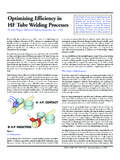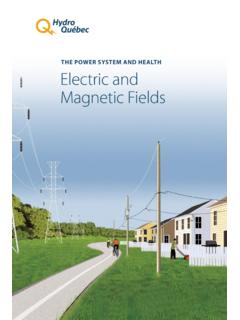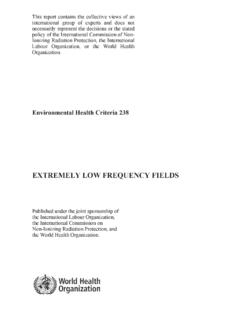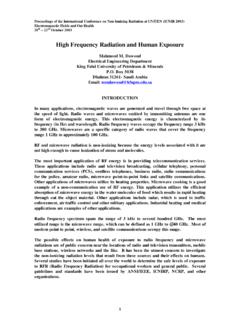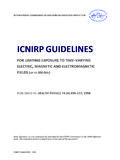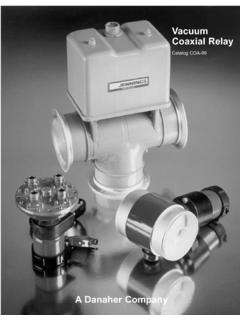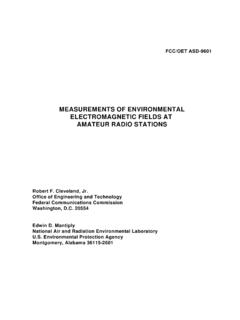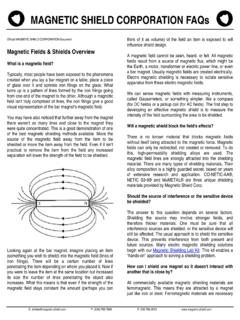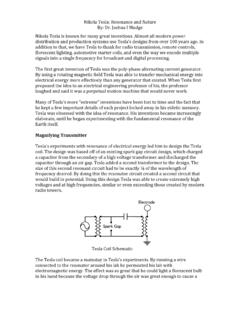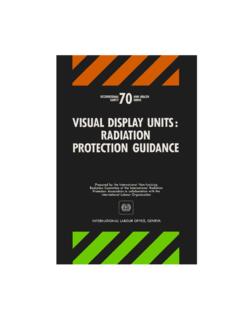Transcription of PRINCIPLES OF HIGH FREQUENCY INDUCTION …
1 Page 1 1997 Electronic Heating Equipment, of INDUCTION TUBE WELDINGPage 1 PRINCIPLES OFHIGH FREQUENCYINDUCTION TUBEWELDING ByJOHN WRIGHTE lectronic Heating Equipment, , WashingtonPage 2 1997 Electronic Heating Equipment, of INDUCTION TUBE WELDINGI ntroductionHigh FREQUENCY INDUCTION welding accounts for themajority of welded tubing produced worldwide, yetit is still a largely misunderstood process. Part of thereason is that the process is very forgiving, however athorough understanding of it can lead to higherproduct yields and of operationInduction welding is a form of Electrical ResistanceWelding (ERW) in which the large rotary trans-former common in low FREQUENCY ERW is replacedby a virtual transformer consisting of the work coil(primary winding) and the tube itself (secondarywinding). A ferromagnetic core inside the tube has asimilar role to the laminated iron core in a conven-tional flowing in the coil causes a magnetic field todevelop surrounding the coil, part of which intersectswith the open tube.
2 This causes an electric field onthe outer surface of the tube which in turn creates avoltage difference across the edges of the strip. At thefrequencies used for INDUCTION welding, the interac-tion between electric and magnetic fields can causecurrents to flow in unexpected ways. The skineffect confines current to within a few thousanths ofan inch of the surface, so the voltage across the stripedges tends to cause current to flow circumfrentiallyaround the inside surface of the tube in the oppositedirection to the induced current on the the faying edges of the strip are in closeproximity to one another from the coil to the apex ofthe vee, they have a very low value of inductance,and it is inductance rather than resistance thatgoverns current flow at high frequencies. This issometimes refered to as proximity effect .It can be seen from this that there are two mainpaths along which current can flow when a voltage isapplied or induced across the edges of the strip.
3 Thekey to operating a high FREQUENCY welder efficiently isto direct the majority of the current along the fayingedges where it does useful work in heating them, andminimise the wasteful parasitic current that flowsaround the inside surface of the is done bymaking the impedance of the vee low relative to thatof the of impederThe first tool we have is called an impeder because itraises the impedance of the tube. An impeder issimply a bar of ferromagnetic material placed insidethe tube within the weld area. Such materials havethe effect of raising the inductance of a circuitsurrounding them. The resistance of the insidesurface of the tube is extremely low but at highfrequencies, it is inductance (or more specificallyinductive reactance) that is the primary factor indetermining current flow. The sum of reactance andresistance is known as impedance. This is the clas-sic explanation of how impeders work, but there aretwo additional factors involved:Materials such as ferrite conduct magnetic fields ina similar way to that in which metals conduct elec-tricity.
4 This is known as magnetic reluctance, and isanalagous to resistivity in metals. Although little orno magnetic field penetrates the wall of the tube (atleast in the case of ferritic (magnetic) tubing), someflux does enter the ferrite through the open vee. Thelow reluctance of the ferrite causes some flux to bedrawn into the impeder, and because there is nowflux inside the tube as well as outside, a correspond-ing electric field is induced on the inside surface ofthe tube. This field has the same polarity as the fieldon the outer surface, so the inductance of the insidesurface further is yet a third method in which impedersimprove the efficiency of INDUCTION welding. Thework coil & the open tube constitute a transformer,albeit a very poor one. Not all of the flux that resultsfrom current flowing in the coil is common to thetube (or secondary winding in our virtual trans-former). This stray flux is represented in transformerdesign as leakage reactance, and it has exactly thesame effect as an equivalent amount of ordinaryreactance placed in series with the secondary.
5 WhenFaying EdgesWork CoilCurrentPage 3 1997 Electronic Heating Equipment, of INDUCTION TUBE WELDING current flows through a reatance, a voltage dropoccurs. In this case, the voltage drop is across theedges of the strip, so more & more current must beforced through the work coil to maintain the voltageacross the ferromagnetic materials conduct magneticflux far better than air, the presence of an impeder ina tube causes more of the coil flux to intersect withthe tube, so leakage reactance is ferromagnetic materials such as iron, nickle& chromium are a poor choice for impeders becausethey have very low electrical resistivity. This resultsin large eddy currents being induced in them, caus-ing uncontrolled heating. Ferrite is a man madesubstance having magnetic properties similar to iron,but much higher resistivity. Some eddy currentheating still takes place, but it is much less thanwould be the case with pure metals, and coolingrequirements become roll arrangementsThe INDUCTION heater just heats the strip edges.
6 Theactual welding occurs as a result of material flowresulting from pressure applied by the squeeze section of the tube mill offers one of the greatestchallenges to the mill designer. The weld pressureunit (or weld box) not only has to provide a veryhigh degree of precision, but it also has to be strongenough to withstand unwelded tube being forcedthrough it. It is the only section of the mill subjectedto high temperatures & thermal shock, and to fur-ther complicate matters, INDUCTION welding geometryrequires that the rolls and supports be as small in the mill is there as much variation indesign philosophy as there is in weld box arrange-ments. Early designs were derived from low fre-quency ERW, with massive lower rolls oncantilevered shafts & smaller head rolls. This ar-rangement is still widely used on large mills. (A)The five roll box (B) is a variation in this desgn thatadds a fifth roll at the bottom of the tube, allowingsmaller diameter side rolls to be smaller mills use three rolls mounted 120degrees apart.
7 Some are orientated with a groovedroll at the top of the tube (D), others with a rolldirectly below the tube. D eliminates edge misalign-ment and is especially suited to D/T ratios above10:1. C provides a means of compensating for edgemisalignment caused by camber in the strip, and ismore frequently used wither lower D/T ratios. Bothmethods work well, and some weld boxes can beinverted, allowing either configuation to be three roll boxes are designed around standard 3jaw lathe chucks. This permits all three rolls to movein or out as a unit, however it also raises or lowersthe metal line due to vertical movement of the lowerroll(s).For very small diameter tubing, a two roll weld box isoften the best. These are the simplest both in con-struction or setup, but difference in surface speedbetween the rim & the root of the rolls is greaterthan with other roll arrangements & this can lead toswirl marking of the tube.
8 Two roll boxes can bemade with the bearing blocks staggered, allowing theuse of very small diameter rolls, however keep inmind that the smaller the roll diameter, the greaterthe rotational speed. Since the same pressure isneeded to create a weld upset with all roll configura-tions, small rolls will have shorter bearing LengthVee length depends on coil position, and to someextent on coil length, since heating starts to occureven before the strip enters the position is usually determined by the diameterand size of the weld roll box, whereas coil length isgenerally dictated by the matching capabilities of are two factors involved here:-1 The high efficiency of INDUCTION welding isdue to the fact that only a very small mass of metal isC: THREE ROLLD: THREE ROLL INVERTEDA: FOUR ROLLB: FIVE ROLLPage 4 1997 Electronic Heating Equipment, of INDUCTION TUBE WELDING heated. Increasing the vee length allows more timefor heat to be conducted away from the edges, somore energy is needed & a wider heat affected distribution of current between the veeand the inside surface of the tube depends on therelative impedances of the two circuits.
9 A longer veehas a higher impedance, which directs more of theavailable current around the inside of the tube. Thisis particularly important when welding small diam-eter tubing, since the small space available for imped-ers limits their are several schools of thought regardingoptimum vee length, but all agree that minimumelectrical power is used with short vee lengths andshort work coils. Power distribution across the edgeface of the strip is fairly even, however there is lessthermal conduction away from the corners, whichmay result in their overheating before the center ofthe edge reaches forging temperature. This tendencycan be reduced by increasing the vee length, or bylowering the welder FREQUENCY (more on this later),so optimum vee length is more a function of wallthickness than it is of diameter. As a general rule, Irecommend using a minimum length vee & theshortest practical work coil unless there is evidence ofuneven temperature distribution.
10 If the weld tends tobe cold in the center, the coil should be moved backthe minimum distance needed to correct the the weld rolls are usually made of steel (D2or H13), they will heat up readily due eddy currentsinduced in them by the work coil. This sets theminimum acceptable clearance between coil & magnetic (ceramic or Ampco 25 bronze) orweakly magnetic (Tungsten carbide) rolls will reduceroll angleThe closer the faying edges are to each other, thelower their inductance will be. This reduces the totalimpedance of the vee, relative to the parasitic currentpath around the inside tube surface. There is a limitto how small a vee angle can be used. As the angle isreduced, any mechanical instability such as breath-ing will cause a greater change in vee length, andtherefore in weld temperature. In addition, at highlevels of INDUCTION , the voltage across the vee can besufficient to ionize the air between the edges, causingarcing.
